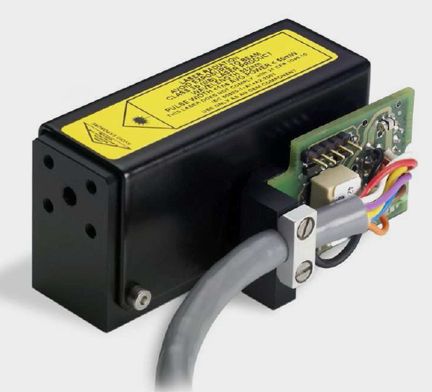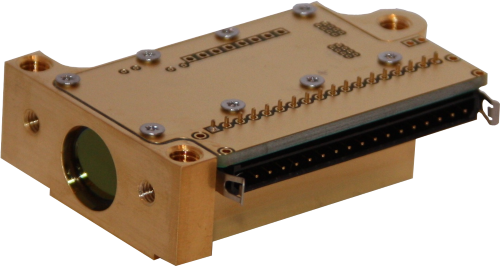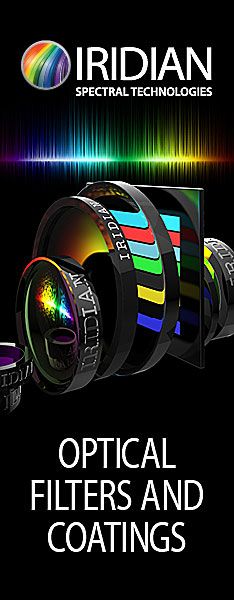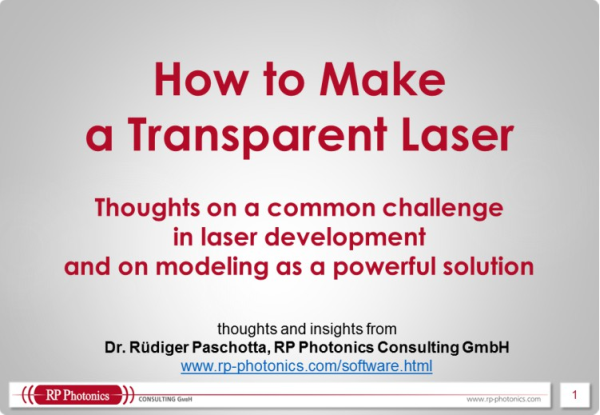Microchip Lasers
Definition: solid-state lasers with a quasi-monolithic setup
More general term: solid-state lasers
German: Microchip-Laser
How to cite the article; suggest additional literature
Author: Dr. Rüdiger Paschotta
Microchip lasers are alignment-free monolithic solid-state lasers [1] where the laser crystal (or glass) is directly contacted with the end mirrors of the laser resonator (see Figure 1). Such lasers are usually pumped with a laser diode (→ diode-pumped lasers), either directly or via an optical fiber. They typically emit a few hundred milliwatts of average power, even though > 1 W is sometimes achieved.

Popular types of laser crystals for microchip lasers are Nd:YAG and Nd:YVO4 for emission in the 1-μm or 1.3-μm region, or sometimes around 0.95 μm. More recently, highly doped ceramic gain media also find increasing interest. Erbium-doped crystals or glasses as gain media allow for eye-safe emission wavelengths [7] in the 1.5-μm region. Shorter wavelengths are obtained with nonlinear frequency conversion (see below).
In some cases, there may be another optical device between the laser medium and an end mirror, e.g. a nonlinear crystal used as electro-optic modulator for Q switching or intracavity frequency doubling, or an undoped transparent plate for improving the power handling capability and increasing the effective mode area.
The term microlaser is also sometimes used for lasers with a very compact resonator setup (i.e. for miniature lasers), but not always in the context of microchip lasers.
Resonator Modes
Most microchip lasers do not have any intentionally curved resonator mirror. The resonator modes are then usually determined by thermal lensing in the laser crystal (including possible bulging of the crystal's end faces), in some cases with a significant influence also from gain guiding [12]. The stability zone of the simple resonator extends from zero focusing power to some maximum value, which is determined by the resonator length. This also determines the minimum beam radius of the fundamental mode. One usually obtains stable diffraction-limited beam quality by pumping a volume within the fundamental resonator mode.
The use of thermal lensing for the formation of resonator modes introduces some limitations, e.g. concerning the possible range of pump powers or the use of gain media with negative dn / dT.
Polarized Emission
For isotropic gain media such as Nd:YAG or for glasses, the gain is the essentially the same for both polarization directions. The laser output may nevertheless be polarized due to weak effects such as thermally induced birefringence, if the pump beam does not have an exactly circular profile.
Single-frequency Lasers
Without special measures, microchip lasers often exhibit single-frequency operation. This results from the short resonator length, which leads to a large free spectral range. When the temperature of the laser crystal changes, the emission frequency may drift in a large range (many gigahertz wide) until a mode hop occurs.
Short Pulse Generation with Microchip Lasers

Due to their short laser resonator with very short round-trip time, microchip lasers are well suitable for generating rather short pulses. The simplest method is gain switching [2], which is already sufficient for obtaining sub-nanosecond pulses.
Q-switched microchip lasers also allow the generation of unusually short pulses with durations below 1 ns, in extreme cases even below 100 ps [10]. This holds particularly for passive Q switching with a SESAM (Figure 2), but it is also possible to use a saturable absorber crystal e.g. of Cr:YAG or some Cr-doped ceramics [14], or to do active Q switching with an integrated Pockels cell.
Particularly with passive Q switching, microchip lasers often allow for very high pulse repetition rates above 100 kHz, sometimes even several megahertz. For lower repetition rates, pulse energies of typically a few microjoules and pulse durations of a few nanoseconds allow for peak powers of multiple kilowatts. The typical trade-offs are discussed in Ref. [10].
Microchip Lasers with Nonlinear Frequency Conversion
Q-switched microchip lasers (see above) allow simple and efficient single-pass nonlinear frequency conversion with external nonlinear crystals, since the peak powers are very high. In the case of continuous-wave operation, efficient intracavity frequency doubling is an option. The latter can be achieved either with a nonlinear crystal bonded to the laser crystal, or by using a self-frequency doubling laser crystal with χ(2) nonlinearity, such as Nd:YCOB. Usually, this leads to green lasers, emitting e.g. at 532 nm.
With further frequency conversion, e.g. via sum frequency mixing, still shorter wavelengths in the ultraviolet spectral region become accessible. It is also possible to pump compact optical parametric oscillators, generating e.g. mid-infrared pulses for spectroscopic applications.
Applications
Microchip lasers find many applications, many of which benefit from a compact and rugged setup and the small electric power consumption. In other cases, the short (sub-nanosecond) pulse durations and/or the possible high pulse repetition rates of Q-switched microchip lasers are of interest. Some examples of applications are:
- Laser range finding with the time-of-flight method can achieve a very high spatial resolution (down to 10 cm or less) due to the short pulse duration.
- The high peak power can also be used for supercontinuum generation in an optical fiber, leading to a kind of spatially coherent white light source.
- Many applications require coherent light with moderate optical powers at various wavelengths, and profit from the simple and efficient nonlinear frequency conversion with short microchip laser pulses.
- Spectroscopic applications and LIDAR (with moderate range) benefit from the small package and the short pulse duration.
- Microchip lasers allow for micromachining with a very compact setup, compared with other laser sources in that area.
Suppliers
The RP Photonics Buyer's Guide contains 15 suppliers for microchip lasers. Among them:


Teem Photonics
The SNP-70F laser Microchip laser series is an advanced 1064-nm designed for high pulse repetition rates and short pulse duration with single longitudinal mode emission.
Teem Photonics also offers a wide range of short pulse lasers, e.g. the eye-safe MNE-06E-100, generating more than 1 kW of peak power. Besides, there are versions with frequency-converted output in the green and in the ultraviolet at 355 nm, 266 nm and 213 nm.


RPMC Lasers
RPMC Lasers offers passively Q-switched microchip lasers that emit high peak power pulses at wavelengths of 1064, 946, 473, 355, 266, and 236.5 nm. These lasers are available with picosecond to nanosecond pulse widths and contain an integral photodiode which can serve as a trigger, for precise timing with detection systems.
Questions and Comments from Users
Here you can submit questions and comments. As far as they get accepted by the author, they will appear above this paragraph together with the author’s answer. The author will decide on acceptance based on certain criteria. Essentially, the issue must be of sufficiently broad interest.
Please do not enter personal data here; we would otherwise delete it soon. (See also our privacy declaration.) If you wish to receive personal feedback or consultancy from the author, please contact him e.g. via e-mail.
By submitting the information, you give your consent to the potential publication of your inputs on our website according to our rules. (If you later retract your consent, we will delete those inputs.) As your inputs are first reviewed by the author, they may be published with some delay.
Bibliography
| [1] | J. J. Zayhowski and A. Mooradian, “Single-frequency microchip Nd lasers”, Opt. Lett. 14 (1), 24 (1989), doi:10.1364/OL.14.000024 |
| [2] | J. J. Zayhowski et al., “Gain-switched pulsed operation of microchip lasers”, Opt. Lett. 14 (23), 1318 (1989), doi:10.1364/OL.14.001318 |
| [3] | J. J. Zayhowski, “Q-switched operation of microchip lasers”, Opt. Lett. 16 (8), 575 (1991), doi:10.1364/OL.16.000575 |
| [4] | J. J. Zayhowski and C. Dill III, “Diode-pumped passively Q-switched picosecond microchip lasers”, Opt. Lett. 19 (18), 1427 (1994), doi:10.1364/OL.19.001427 |
| [5] | J. J. Zayhowski and C. Dill III, “Coupled-cavity electro-optically Q-switched Nd:YVO4 microchip lasers”, Opt. Lett. 20 (7), 716 (1995), doi:10.1364/OL.20.000716 |
| [6] | D. G. Mathews et al., “Blue microchip laser fabricated from Nd:YAG and KNbO3”, Opt. Lett. 21 (3), 198 (1996), doi:10.1364/OL.21.000198 |
| [7] | R. Fluck et al., “Eyesafe pulsed microchip laser using semiconductor saturable absorber mirrors”, Appl. Phys. Lett. 72, 3273 (1998), doi:10.1063/1.121621 |
| [8] | R. S. Conroy et al., “Self-Q-switched Nd:YVO4 microchip lasers”, Opt. Lett. 23 (6), 457 (1998), doi:10.1364/OL.23.000457 |
| [9] | J. J. Zayhowski, “Passively Q-switched microchip lasers and applications”, Rev. Laser Eng. 26, 841 (1998), doi:10.1016/S0925-8388(00)00647-2 |
| [10] | G. J. Spühler et al., “Experimentally confirmed design guidelines for passively Q-switched microchip lasers using semiconductor saturable absorbers”, J. Opt. Soc. Am. B 16 (3), 376 (1999), doi:10.1364/JOSAB.16.000376 |
| [11] | T. R. Schibli et al., “Continuous-wave operation and Q-switched mode locking of Cr4+:YAG microchip lasers”, Opt. Lett. 26 (12), 941 (2001), doi:10.1364/OL.26.000941 |
| [12] | N. J. van Druten et al., “Observation of transverse modes in a microchip laser with combined gain and index guiding”, J. Opt. Soc. Am. B 18 (12), 1793 (2001), doi:10.1364/JOSAB.18.001793 |
| [13] | D. Nodop et al., “High-pulse-energy passively Q-switched quasi-monolithic microchip lasers operating in the sub-100-ps pulse regime”, Opt. Lett. 32 (15), 2115 (2007), doi:10.1364/OL.32.002115 |
| [14] | J. Dong et al., “Composite Yb:YAG/Cr4+:YAG ceramics picosecond microchip lasers”, Opt. Express 15 (22), 14516 (2007), doi:10.1364/OE.15.014516 |
| [15] | R. Bhandari et al., “Efficient second to ninth harmonic generation using megawatt peak power microchip laser”, Opt. Express 21 (23), 28849 (2013), doi:10.1364/OE.21.028849 |
See also: solid-state lasers, monolithic solid-state lasers
and other articles in the category lasers

This encyclopedia is authored by Dr. Rüdiger Paschotta, the founder and executive of RP Photonics Consulting GmbH. How about a tailored training course from this distinguished expert at your location? Contact RP Photonics to find out how his technical consulting services (e.g. product designs, problem solving, independent evaluations, training) and software could become very valuable for your business!
 |






If you like this page, please share the link with your friends and colleagues, e.g. via social media:
These sharing buttons are implemented in a privacy-friendly way!